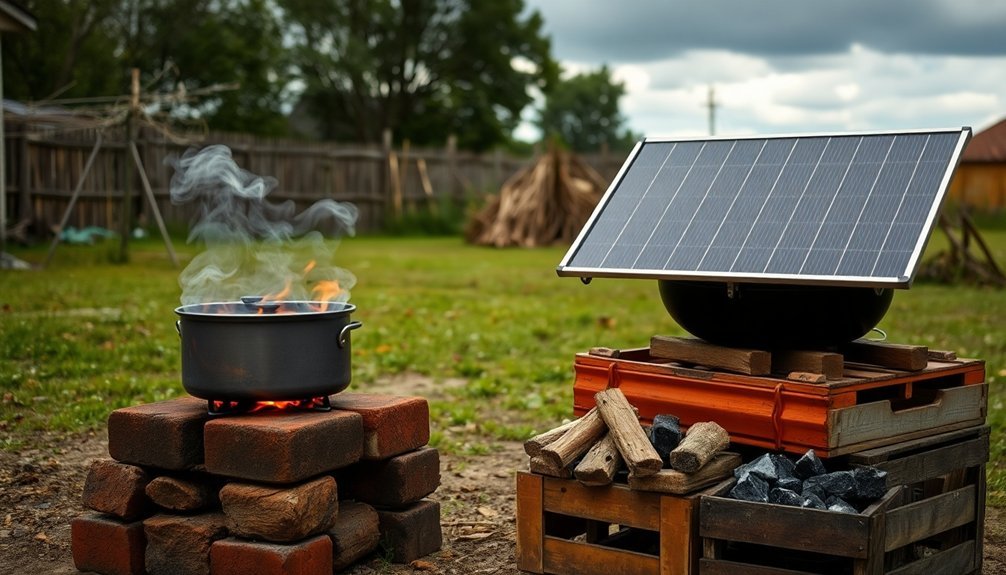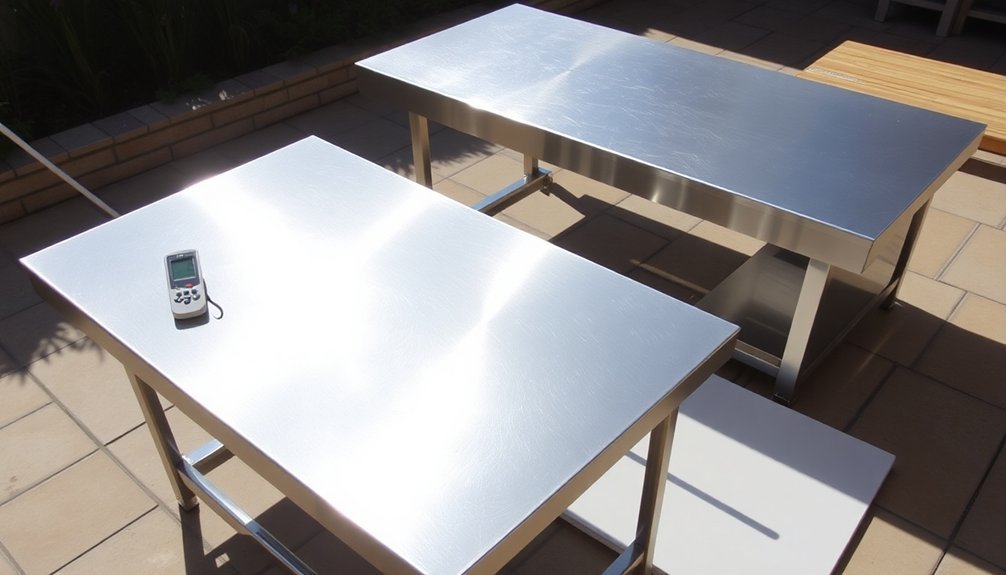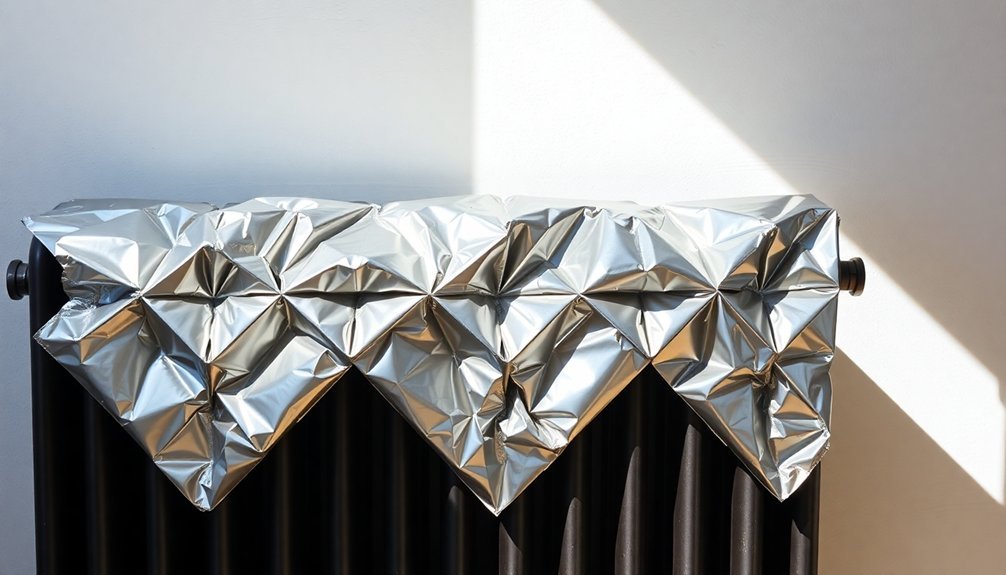When clouds block your solar cooker, you'll want reliable backup methods ready to go. Keep a portable gas stove or multi-fuel camping burner on hand for quick meal preparation during overcast conditions. A biogas system can serve as an eco-friendly alternative, converting your kitchen waste into cooking fuel. For maximum flexibility, consider setting up a hybrid solar-electric oven or maintaining traditional fuel-based options like propane. You'll also benefit from storing emergency fuels properly and checking weather forecasts before planning solar-dependent meals. Understanding all your alternative cooking options will help you stay prepared for any weather scenario.
Understanding Weather's Impact

When it comes to solar cooking, weather conditions play an essential role in your success.
You'll need to understand how different weather patterns affect your solar cooker's performance to plan effectively.
Cloud cover is your biggest challenge, as it blocks direct sunlight and can make cooking impossible on heavily overcast days.
While high temperatures and bright sunshine will boost your cooker's efficiency, humidity and rain can considerably slow down or stop the cooking process altogether.
You'll also face challenges from wind, which can destabilize your cooker and reduce its effectiveness.
Cold temperatures make it harder to maintain the heat needed for cooking. Professional maintenance checks twice yearly can help ensure your solar cooker remains in optimal condition for when weather permits use.
That's why it's imperative to check weather forecasts before planning your solar cooking and have alternative cooking methods ready when conditions aren't favorable.
Essential Backup Cooking Methods
You'll find gas stoves provide a reliable backup when solar cooking isn't possible, offering quick and efficient meal preparation during cloudy days or nighttime.
For safer food preparation, practicing proper material safety protocols when switching between cooking methods helps prevent cross-contamination and ensures consistent results.
If you're seeking an eco-friendly alternative, biogas systems can seamlessly integrate with your existing cooking routine while maintaining sustainable practices.
Your cooking workflow won't skip a beat when you pair these methods with your solar cooker, ensuring you're always ready to prepare meals regardless of weather conditions.
Gas Stoves Save Time
Gas stoves offer three compelling advantages as backup cooking methods: speed, control, and reliability.
You'll appreciate how quickly they heat up, allowing you to prepare meals in less time than with traditional electric stoves. When clouds block your sun cooker, you can switch to gas and still get dinner on the table fast.
You'll have precise control over cooking temperatures by adjusting the flame to exactly where you need it. This visual feedback helps you maintain the perfect heat level for any dish. The visible flame indication ensures you always know your current heat setting at a glance.
Best of all, gas stoves keep working during power outages – just light the burners manually. You'll also save money on utility bills since natural gas costs less than electricity, and these stoves typically need minimal maintenance.
For ultimate versatility, consider a dual fuel range that combines a gas cooktop with an electric oven.
Biogas Keeps Cooking Simple
Converting your kitchen waste into cooking fuel creates a sustainable backup option through biogas production. You'll get about 200 liters of biogas from each kilogram of food waste – enough for an hour of cooking. When clouds block your sun cooker, your biogas stove stands ready. A typical biogas system produces enough fuel to cook a main meal daily from regular kitchen scraps.
| Biogas System Component | What You Need to Know |
|---|---|
| Gas Production | Keep digester at 20-45°C in airtight conditions |
| Stove Modification | Remove LPG nozzle, widen burner holes to 3mm |
| Gas Quality | Initial gas won't burn; wait for methane-rich production |
| Safety Checks | Test with Bunsen burner, verify pressure, check for leaks |
You'll need to modify your LPG stove for biogas use by adjusting the air-gas mixture and flame openings. While biogas has lower heat value than LPG, it's an efficient, environmentally friendly cooking solution that turns waste into energy.
Portable Stove Options

You'll find compact gas stoves running on propane or isobutane offer reliable backup cooking when your sun cooker isn't usable.
For maximum versatility, consider dual-fuel models like the Gas One GS-3400P, which can run on either propane or butane and delivers 8,000 BTU of cooking power.
Multi-fuel camping burners give you even more flexibility, with options like the Outdoor Element Titanium Stove that can use wood, charcoal, or biomass as fuel sources.
Compact Gas Stoves
When sun cooking isn't feasible, compact gas stoves offer a reliable backup solution that combines portability with powerful cooking capabilities.
You'll find these stoves in 20-inch or 24-inch widths, perfect for small kitchens or outdoor spaces.
These units pack impressive features into their small frames. You can choose from multiple burner configurations, including high-output options up to 17,400 BTU, with sealed burners that prevent spills from seeping below.
The cast iron grates guarantee even heat distribution, while electronic ignition provides safe, efficient lighting.
Despite their compact size, these stoves don't skimp on oven performance. With capacities around 2.6 cubic feet and features like Temp Assure™ systems, you'll get consistent cooking results.
Most models come with LP conversion kits and essential safety features, making them versatile alternatives for cloudy days.
Multi-Fuel Camping Burners
Multi-fuel camping burners stand out as another reliable backup option for sun cooking, offering remarkable versatility in the field.
You'll appreciate their ability to burn various fuels, from alcohol to solid tabs and gels, ensuring you're never left without cooking capabilities when clouds appear.
These titanium-constructed stoves combine durability with ultra-light design, typically weighing just one ounce.
- Burns consistently for up to 20 minutes with alcohol fuel
- Adapts easily between fuel types with minimal tool requirements
- Features folding legs and pot supports for enhanced stability
- Functions efficiently in diverse weather conditions with proper windscreening
For maximum effectiveness, you'll want to match your fuel choice to your environment and availability.
The stove's compact design makes it an ideal emergency backup that won't weigh down your pack while ensuring you can always prepare hot meals.
Biogas Systems for Cloudy Days
Smart energy planning requires a reliable backup system, and biogas delivers consistent power when the sun isn't shining. You'll get 24/7 energy availability for cooking and power generation, regardless of weather conditions.
Your biogas system can integrate seamlessly with solar technology. Solar panels can heat your biogas digesters to maintain ideal temperatures between 30-40°C, ensuring steady microbial activity and maximum gas production. This setup is particularly valuable in colder climates.
You won't need expensive batteries since biogas stores naturally as methane. The system adapts to weather changes automatically, increasing biogas production when solar input decreases.
Dynamic management algorithms can enhance the balance between your biogas and solar resources, maximizing efficiency while minimizing costs. It's a sustainable solution that keeps your energy flowing even on the cloudiest days.
Emergency Fuel Storage Tips

Store your emergency cooking fuels in approved, properly labeled containers, keeping gasoline in red containers and diesel in yellow ones.
Maintain them in a well-ventilated, detached structure away from your living space.
You'll need to rotate gasoline every 3-6 months and diesel every 18-24 months, though fuel stabilizers can extend these periods.
For maximum safety, keep your fuel storage area free of debris, equipped with fire extinguishers, and maintain safe distances from ignition sources and oxidizing agents.
Safe Storage Methods
Proper fuel storage plays a critical role in maintaining your backup energy system's safety and reliability.
You'll need to store fuel at least 50 feet from ignition sources and guarantee proper ventilation to prevent vapor buildup. Always use D.O.T. approved containers placed on level ground with secondary containment systems.
- Double-walled tanks offer the best protection against leaks and damage
- Military-grade jerry cans provide excellent durability for smaller quantities
- Flexible fuel bladders work well for temporary storage needs
- Portable metal drums and plastic containers give you mobility options
Remember to inspect your storage containers regularly for wear and tear.
Keep them in temperature-stable locations away from direct sunlight, and always wear appropriate safety gear when handling fuel.
Don't forget to clearly label all containers with the fuel type and storage date.
Types Of Emergency Fuels
Three primary emergency fuels – gasoline, diesel, and propane – form the backbone of most backup energy systems.
You'll need to store gasoline in metal or plastic containers no larger than five gallons, filling them to 95% capacity. While untreated gas lasts 3-6 months, stabilizers can extend its life to a year.
Diesel offers more forgiveness with a one-year shelf life, but you'll need to watch for gel formation in cold weather. Use Pri-D stabilizer to maintain quality.
Propane stands out as the most reliable option, lasting indefinitely when properly stored, and you can even convert your gasoline generators to run on it.
For additional options, consider kerosene (five-year shelf life), gel fuel, butane for portable stoves, or alcohol-based fuels.
Biomass briquettes can round out your emergency fuel stockpile.
Alternative Energy Solutions
When clouds obstruct your solar cooker, having reliable backup cooking methods guarantees you can still prepare meals effectively.
You'll find several practical alternatives that offer dependable performance regardless of weather conditions.
Consider these proven backup solutions:
- Electric cooking provides consistent results and precise temperature control, though you'll need reliable power access.
- Propane and gas systems offer portability and quick cooking times, making them ideal temporary alternatives.
- Traditional fuel-based methods give you reliable performance but require ongoing fuel purchases.
- Biomass cooking uses readily available materials, though it's less sustainable long-term.
Each option has distinct advantages, so you'll want to choose based on your specific needs, local resources, and environmental concerns.
Remember to factor in both immediate convenience and long-term sustainability when selecting your backup cooking method.
Weather Forecasting for Solar Cooking

Successful solar cooking relies heavily on accurate weather prediction to maximize cooking efficiency.
You'll need to monitor several key factors to plan your cooking schedule effectively. Surface weather stations track sunshine hours using Campbell-Stokes recorders, while satellites provide broader coverage of potential cooking conditions.
To determine if you'll have enough sunlight, look for forecasts predicting at least 6 hours of direct sunshine.
Keep in mind that your location matters – areas near the equator often face cloud cover challenges, especially in January, while desert regions like northern Chad typically offer more reliable cooking days.
Watch for dust loads in areas near the Sahara and Arabia, as they can greatly reduce solar effectiveness.
Also check wind speeds and humidity levels, as they'll affect your cooker's performance.
Maintaining Multiple Cooking Sources
Reliable solar cooking requires maintaining multiple cooking sources to guarantee uninterrupted meal preparation.
You'll want to combine different technologies to ascertain you can cook in any situation. A hybrid solar-electric oven lets you switch between solar and electric power, while connecting portable solar panels to battery packs provides backup energy for traditional electric stoves.
- Keep a hybrid solar-electric oven like the Gosun Fusion that runs on both sunlight and 12V power
- Set up solar panels with battery storage and an inverter for your electric stove
- Maintain basic solar thermal cookers made from simple materials for emergencies
- Store portable power banks and backup batteries for cooking after sunset
This diversified approach ascertains you'll always have a way to prepare meals, regardless of weather conditions or time of day.
Traditional Cooking Methods

Beyond modern backup systems, traditional cooking methods offer time-tested alternatives that don't rely on technology or sunlight. You'll find these methods particularly reliable in any weather condition.
Try slow cooking in a traditional pot to tenderize tough meats while enhancing flavors and nutrient absorption. You can also explore ancient techniques like earth ovens or stone boiling, which have sustained cultures for thousands of years.
For a healthier approach, consider grilling or steaming – both methods preserve nutrients while reducing fat content.
Don't overlook the power of fermentation to preserve food and boost nutritional value. When preparing spices, you'll get the most flavor by crushing them fresh with a mortar and pestle.
These traditional methods aren't just backup options; they're proven cooking techniques that can enhance your culinary skills.
Smart Kitchen Layout Strategies
When designing your kitchen for solar cooking, a well-planned layout serves as the foundation for efficient meal preparation. Optimize your space by implementing the kitchen work triangle, positioning your sink, stove, and food storage areas in a triangular configuration.
You'll want to maintain clear pathways and designate specific zones for prep work, cooking, and cleanup.
Consider these layout enhancements for your solar cooking backup station:
- Install vertical storage solutions with ceiling-height cabinets for rarely used equipment
- Create a dedicated prep zone near your conventional cooking area
- Incorporate pull-out shelves and deep drawers for easy access to pots and supplies
- Maximize counter space around key work zones with an island or peninsula
Remember to keep frequently used items within arm's reach and organize your workspace using the 'mise en place' system.
Frequently Asked Questions
How Long Can Prepared Food Stay Warm in a Solar Cooker?
You'll find your food can stay warm for 2-4 hours in a well-insulated solar cooker after sunset, especially if you've added thermal mass like rocks or bricks and keep the lid tightly closed.
Can Solar Cookers Be Used Effectively at High Altitudes?
Yes, you'll find solar cookers work exceptionally well at high altitudes. You'll benefit from stronger direct sunlight, less atmospheric interference, and clearer skies. Your cooking efficiency can actually improve compared to lower elevations.
What Materials Should I Avoid Using in My Solar Cooker?
You'll want to avoid cardboard, single glazing, non-tempered glass, and unsecured aluminum foil. Don't use materials that degrade with moisture, emit gases when heated, or lose reflectivity over time.
How Do Different Colored Cooking Pots Affect Solar Cooking Performance?
You'll get better performance with dark-colored pots since they absorb sunlight efficiently and convert it to heat quickly. Light-colored pots reflect sunlight instead, making them less effective for solar cooking.
Are There Health Risks Associated With Repeatedly Reheating Food in Solar Cookers?
Yes, you'll face health risks if you repeatedly reheat food in solar cookers. When food stays in the danger zone (50-125°F) for 3-4 hours, bacteria multiply rapidly. Always guarantee thorough reheating to 165°F.
In Summary
You'll always need reliable backup cooking methods when using a sun cooker, as weather can be unpredictable. Keep your emergency fuel stored properly, maintain multiple cooking options, and regularly check weather forecasts to plan ahead. Whether it's a portable stove, biogas system, or traditional cooking method, your backup plan guarantees you're never caught off guard when clouds block your solar cooking setup.





Leave a Reply